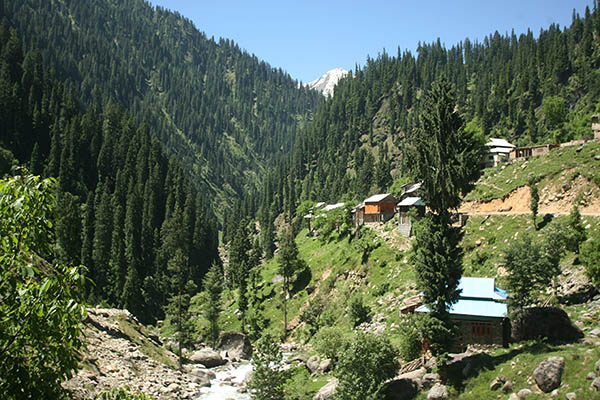People from across Pakistan are visiting Neelum Valley despite lingering security threats.
Success stories can be rare in Pakistan, but business is booming in one Kashmir tourist spot as the region rebuilds after a devastating earthquake and shrugs off associations with violence.
Hundreds of thousands of Pakistani tourists drawn to the lakes and glaciers of the Neelum Valley are injecting desperately needed money into one of the poorest parts of the country.
Westerners stopped coming to the Himalayas of Pakistan-administered Kashmir years ago, put off by its reputation as a training ground for Islamist militant groups and the risk of sporadic conflict with India. But with a new road built by the Chinese after the 2005 earthquake killed 73,000 people and a ceasefire holding with India, Pakistanis are discovering the snow-capped peaks, glaciers, lakes, and lush-green meadows of the Neelum Valley.
Known locally as “Paradise on Earth,” the valley is 114 kilometers east of the base camp in Gilgit-Baltistan where gunmen shot dead American, Chinese, Lithuanian, Slovakian, and Ukranian climbers in June. It was the worst attack on foreigners in Pakistan for a decade, but in neighboring Kashmir, few Pakistanis are worried.
“There is a bit of fear there, but overall we are enjoying ourselves and we will stay according to our plan,” said Mohammad Amir, a lawyer on holiday with his family from southern Punjab.
Munazza Tariq, a university student from Karachi, agrees: “This was carried out by enemies of Pakistan. After it happened, we received a lot of calls from our relatives from Karachi, but we are safe and enjoying ourselves.”
Local tourism ministry official Shehla Waqar says 600,000 people visited Neelum last year compared to 130,000 in 2010, before the Chinese built a road linking the area to Muzaffarabad, the capital of Pakistan-administered Kashmir. “There is an influx of tourists in the area because we have a very beautiful road from Muzaffarabad to the Neelum Valley. This area is very peaceful and there is no fear of terrorism,” she said.
The nearby Line of Control slices apart the Indian- and Pakistani-administered zones of the Himalayan region where a ceasefire has held since November 2003. Sporadic clashes killed six soldiers in January and February, but officials on both sides have kept tensions in check and Pakistan’s newly elected prime minister, Nawaz Sharif, has put improving relations with India at the cornerstone of his foreign policy.
By contrast, Taliban attacks in the northwest—where mountain resorts have in the past sucked domestic tourism away from Kashmir—and the impact of crippling power cuts pushing people toward balmier climes is also driving visitor numbers higher, Waqar said.
There are now 115 registered guesthouses in the Neelum Valley, according to local deputy commissioner Mohammad Farid, compared to none in 2010. The authorities say they have stepped up security after the climbers were killed in Gilgit-Baltistan, but because tourists in Kashmir are Pakistani rather than foreign, they are not braced for a serious knock-on effect.
“We have strict instructions that all government and private guesthouses are to close their main gates at 10 p.m.,” said Kashmir tourism minister Abdul Salam Butt. “No doubt this incident has damaged international tourism in Pakistan, but it won’t affect Kashmir because we host domestic tourists.”
Raja Zarat Khan, who owns a private guesthouse, said he was fully booked into the next week and he had no cancellations. “I’m having a great season,” he said.
Mohammad Awais, 44, runs a restaurant, a string of guesthouses, and now also takes tour groups to the Neelum Valley. “This business has changed my life. Last year I did excellent trade because I gave tourists a lot of incentives: hiking, trekking, fishing, boating. The environment in Neelum Valley is very good. Once you enter the valley, no one wants to leave.”
He also doesn’t expect the Gilgit shootings to have a major impact. “It hasn’t made a big difference—perhaps four to five percent because the elite class, who come here, feel insecure, but no one has cancelled any bookings. People are still coming,” he said.
The boom is welcome in a region where many men have traditionally left behind their families to work in Pakistan’s largest cities.
Awais has hired cleaners, cooks, drivers, and tourist guides: all men who would otherwise be unemployed. Suppliers have benefited. Villagers even sell their freshly grown cherries, apricots, and plums to tourists.
But others warn that more needs to be done to sustain the boom across the rest of Pakistan-administered Kashmir. “There are some beautiful places in our area, but there are no proper roads available and the tourists can’t go to these areas,” said Khawaja Abdul Samad, who is thinking about opening his own hotel.


1 comment
Muzaffarabad is a nice place to visit with tour guide